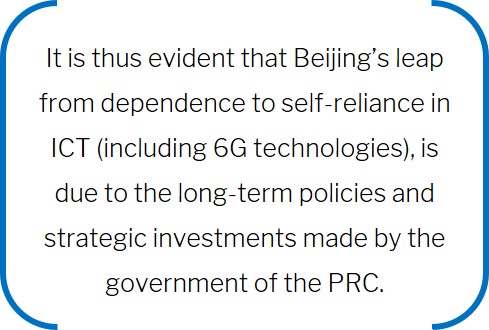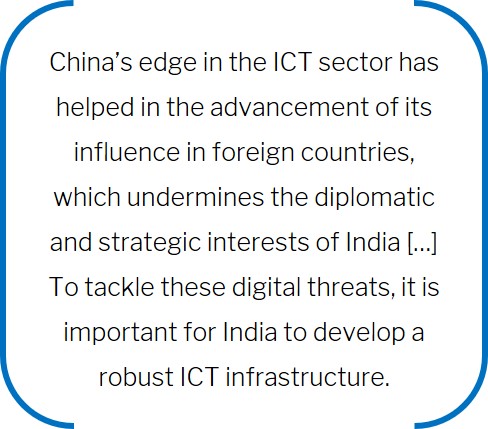–Subhadip Mondal, Research Assistant, ICS
In the field of Information and Communications Technology (ICT) India is trailing behind China. In June 2021, the Chinese government published its white paper on 6th generation mobile communication (6G), but India took another year to come up with its working plan regarding 6G implementation. Back in 2019, Beijing rolled out 5th generation mobile communication (5G) services whereas it was only in 2022 that India’s Union Cabinet approved the auction of its 5G spectrum. In India’s case, Chinese companies were kept out, and this decision has come at a time when diplomatic relations between the two countries has been erratic since the Doklam stand-off. New Delhi is not alone in the move to keep Chinese companies out of its ICT infrastructure development. In 2019, former US President Donald Trump signed an Executive Order to exclude Chinese 5G companies from the American telecom network. The Biden Administration has maintained this effort and persuaded its allies to curtail the predominance of Chinese ICT companies. These measures raise questions about the extent of Beijing’s dominance in ICT. These include: how the present scenario came into being, what would its impact be on India, and the measures New Delhi may adopt to tackle the emerging scenario. This research blog will try to answer these questions on the basis of a study of the official documents, reports, white papers, and research articles.
China’s Telecom History
The roots of China’s growth in ICT date back to the liberalisation of the Chinese economy in the 1980s. As this initiative caused a boom in the ICT sector, Beijing upgraded its indigenous ICT capacity. To enter the Chinese market, foreign vendors were required to form Joint Ventures (JVs) with Chinese partners. Their import capacity was also limited, depending upon their localized production and transfer of technology. These measures helped in the development of indigenous industries. Although, by 1996 Beijing had choked the import of telecom equipment, in 2008, China accounted for over one-fifth of Qualcomm’s global revenue, which is an American company. This came from the royalties for Code-Division Multiple Access (CDMA), which was used for the 2nd generation (2G) and 3rd generation (3G) communication. This pushed Chinese companies to take up a more elaborate participation in international standards-setting processes for the telecom sector. This facilitated the rise of Chinese companies in the field of advanced communication technologies like 5G, 6G, and so on. Due to this, as of 2021, China had the greatest number of 6G-related patents, most of which were filed by Huawei, the State Grid Corporation of China, and China Aerospace Science and Technology. It is thus evident that Beijing’s leap from dependence to self-reliance in ICT (including 6G technologies), is due to the long-term policies and strategic investments made by the government of the PRC.

China’s Growth in ICT
The PRC government’s investments in ICT through state-owned enterprises (SOEs), private companies and systemic policy changes helped Beijing break the dominance of foreign companies. For instance, as of 2019, Huawei had received over 75bn USD in financial assistance from the state, which helped the company avoid foreign competition by a huge margin. In terms of long-term policies, in 2015 China’s State Council published their ‘Made in China 2025’ policy. The policy highlighted the state’s intention to make major breakthroughs in telecom technology including 5G. The 13th Five Year plan was the first such plan that laid the road map for the implementation of 5G connectivity. It also highlighted projects linked to Quantum Communication, Big Data, and Smart Grid, among others. The 13th Plan even proposed workshops and training to cultivate young minds and talents which would play a crucial role in implementing these projects. Beijing’s edge in 5G helped its advancement in Quantum technology. Last year China Telecom announced a secure quantum phone service using 5G. In the same year, China launched a quantum satellite which would help Beijing to establish secure communication around the globe. As of September 2022, China’s 5G users numbered around 1.01 billion.
China and 6G
Beijing’s white paper on 6G stressed that the successful commercialization of 5G will lay the foundation for the development of 6G. So, the success of 5G propelled the government to take up initiatives for the implementation of 6G. The roadmap for this was laid down in the 14th Five-Year Plan, which expressed special interest in the successful roll-out of 6G. To this end, it proposed to increase 5G users by 56%, and to promote the commercial deployment of Internet Protocol version 6 (IPv6).China’s 6G roll-out plan focussed on attaining high data transfer rate and negligible latency, which will be crucial in handling Big Data. To handle multiple data points and data, the plan proposes to integrate the 6G network with Artificial Intelligence (AI). The plan also showcased the need for new cyber security infrastructure, given that new technologies bring new threats. The roll-out of 6G will enhance the capabilities of the People’s Liberation Army (PLA), given that under Xi Jinping China is employing Military Civil Fusion (MCF) to position the country to compete militarily and economically in an emerging technological and strategic environment. 6G-powered AI will help in modernizing the PLA, and its zero-latency capability will help the PLA gain supremacy in the field of unmanned vehicles. The high data transmission and low latency will have further military benefits as well, such as gathering intelligence, visualizing combat operations, and delivering precise logistical support.
India’s road toward 6G
Developments in China’s military capabilities and the related ICT sector potentially constitute a challenge, if not a threat for India. In February 2022, India rolled-out its Work Plan Roadmap on 6G. However, for its success, the implementation of 5G services needs to be successful. The laying down of policies for 5G dates back to 2018. In that year, the National Digital Communication Policy (NDCP) was published. It was the first such policy to highlight the importance of 5G. Then, in February 2019, the Telecom Regulatory Authority of India (TRAI) published a white paper regarding the enabling of 5G in India. In their report, the 3300-3600 MHz spectrum was earmarked for Indian Space Research Organization (ISRO). This band can be used for Quantum Key Distribution (QKD) over 5G to achieve transmission with less latency. ISRO has completed the test run of QKD using the Navigation with Indian Constellation (NavIC) receiver. The Government of India (GoI) has taken other initiatives for successful implementation of 5G as well. On September 2020 TRAI came out with a White Paper regarding the plan to integrate 5G communication technologies within the infrastructure of Smart Cities. But the ground reality falls short in achieving the targets set by these policy papers. These inconsistencies thus impact the overall strength of India’s ICT infrastructure and also the future of 6G in India.

Conclusion
China’s edge in the ICT sector has helped in the advancement of its influence in foreign countries, which undermines the diplomatic and strategic interests of India. Through the Digital Silk Road initiative, Beijing has invested in digital infrastructure in multiple countries. For instance, Huawei is developing 5G networks across both Pakistan and Myanmar, which constitute a source of strategic concern for India.
To tackle these digital threats, it is important for India to develop a robust ICT infrastructure. For this, GoI needs to work on achieving the targets fixed by its policy papers. TRAI’s paper on 5G projected 70 million 5G connections by 2025, but by modest estimates made by the Indian media, as of February 2023, the total user base stand around 20 million.
Beijing’s ICT capability, especially in terms of 6G, makes it imperative for India to invest more in its own ICT research and development. It also needs to train young scholars and engineers which will be the back bone for implementing new projects and carry out advanced research in ICT. In this respect, institutions like IITs and Central Universities will play a crucial role. Furthermore, India needs to invest more in its Public Sector Undertakings (PSUs) so that they can undertake advanced researches to gain edge in advanced communication technologies. Later, this expertise can be exported through India’s ‘Neighbourhood First Policy’. This would help New Delhi to counter the growing influence of Beijing in its neighbourhood. These initiatives are investment-driven. Since India holds the presidency of the G20 this year, this is an opportunity to secure investment from like-minded nations for the development of ICT infrastructure in India, and counter China’s growing dominance in the field.